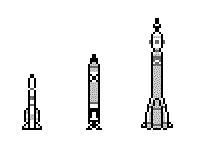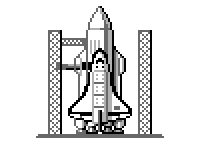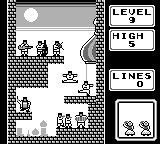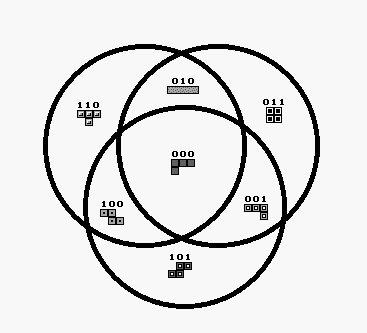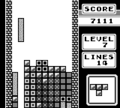From Hard Drop Tetris Wiki
| Tetris | |
|---|---|
 | |
| Release Information | |
| Developer | Nintendo |
| Publisher | Nintendo |
| Platform | Game Boy |
| Release Date | 14 Jun 1989 31 Jul 1989 28 Sep 1990 |
| Gameplay Information | |
| Next pieces | 1 |
| Playfield dimensions | 10x18 |
| Rotation system | Nintendo Rotation System, left-handed |
| Hold piece | ✗ |
| Hard drop | ✗ |
| Has 180° rotation | N/A |
| Adjustable tuning | N/A |
| Websites | |
Tetris, for Game Boy, is among the most played of its namesake. Nintendo, through the help of Henk Rogers, purchased the license from Elorg to package it with every new non-Japanese Game Boy system. Because of this, many players of the Game Boy generation remain familar to this title, as it probably sold more than any other Tetris title so far. Having Tetris packaged with Game Boy may likewise have had something to do with Game Boy's success. It also made "Korobeniki" become the "Tetris song", and as a result, part of the Tetris Guideline, and a registered trademark of TTC (77037539).
This was the first widely distributed Tetris game to feature 2-player battles with garbage using the link cable.
Details
Game Boy runs at 59.73 frames per second.
- Soft drop: 1/3G
- ARE: 2 frames (tetromino is invisible for first frame after it spawns)
- ARE+line clear: 93 frames
- DAS: 23 frames for initial delay, 9 frames for autorepeat
Speed levels:
| Level | Frames per row |
|---|---|
| 0 | 53 |
| 1 | 49 |
| 2 | 45 |
| 3 | 41 |
| 4 | 37 |
| 5 | 33 |
| 6 | 28 |
| 7 | 22 |
| 8 | 17 |
| 9 | 11 |
| 10 | 10 |
| 11 | 9 |
| 12 | 8 |
| 13 | 7 |
| 14 | 6 |
| 15 | 6 |
| 16 | 5 |
| 17 | 5 |
| 18 | 4 |
| 19 | 4 |
| 20 | 3 |
This table is located at 1B06h in the ROM; each entry is one less than the actual number of frames. For example, level 1, or 49 = 31h frames, is stored as 30h.
In Marathon (called A-TYPE), when the player line clear (startLevel * 10 + 10), the level advances by 1. After this, the level advances by 1 for every 10 lines
On level 0, the player gets 40 points for a Single, 100 points for a Double, 300 points for a Triple and 1200 points for a Tetris. On higher levels, those points are multiplied by (level + 1). On the other hand, softdrop points are not multiplied by the current level.
The "heart levels" (activated by holding Down+Start at the title screen) are as fast as the level plus 10, but unlike on the NES version, they don't improve the score.
The maximum Score is 999,999.
Rockets & Dancers
In A-TYPE, a missile launch is shown when the player surpasses a certain score.
- 100,000 to 149,999 points: small missile
- 150,000 to 199,999 points: medium-sized missile
- 200,000 or more points: big missile
In B-TYPE, a screen with Russian musicians and dancers is shown when completing 25 lines on level 9. The number of dancers increase with the initial height level. When completing level 9 + height 5, a Buran shuttle launch is shown additionally.
Randomizer
It was intended that the randomizer reduces the chances of getting one and the same piece shape 3 times in a row. However, the randomizer works differently in practice. Pieces are numerated from 0 to 6, repectively from 000 to 110 in binary notation. The code uses a bitwise OR operation. This is an operation that takes 2 binary numbers to compute a new binary number. The result has a 1 at a certain digit if at least one of the 2 arguments has a 1 at the same digit. For example 1100 OR 1010 = 1110. The following happens:
Choose a random piece shape. Hand it out as next but one piece, if the bitwise OR of the locking piece, the preview piece, and the chosen piece differs from the locking piece. Otherwise ( locking OR preview OR chosen = locking ), choose another piece (can be the same as before). Accept it as the next but one piece if the condition is fulfilled this time. Otherwise, choose another piece and use it as the next but one piece (no matter if the condition is fulfilled or not).
Piece shapes containing many zeros in the bitwise notation are rejected more often. Let's say our preview piece is a L (000). Then, another L will be rejected in the condition no matter of the locking piece (XXX OR 000 OR 000 = XXX ). So the chance of getting 2 L pieces in a row is reduced significantly. As a result, piece shapes containing many zeros appear less frequent. The relative frequencies should be as follows:
- L: 10.7 %
- J, I, Z: 13.7 %
- O, S, T: 16.1 %
Henk Rogers takes responsibility for this randomizer.[1][2]
Sales
With 30 million copies worldwide, Tetris is the second best selling Game Boy title after Pokemon Red / Blue. 23 million copies were sold in North America alone, because it was packaged with every original Game Boy there. In Japan, where no game game was packaged with a Game Boy, Tetris sold as well as Super Mario Land (around 4.2 million copies).
Version 1.0
Around 10,000 cartridges of this prototype version were produced in Japan.
- It features the song "Minuet", while version 1.1 features "Korobeniki". The level up sound is less conspicuous.
- In A-TYPE, the player needs 50,000 less points for the rocket starts (50,000 points for small missile, 100,000 for medium, 150,000 for big).
- Level progression differs: From level 0 to 8, a player has to clear 10 lines to reach the next level. From level 9 to 20, it's 20 lines to the next level. This is independent from the start level: When starting on level 9, it's only 20 lines to level 10, but 220 lines to level 20. When starting on level 0, it's 90 lines to level 9, 110 lines to level 10 and 310 lines to level 20.
- Inputs during line clears are not ignored. This allows to charge Delayed Auto Shift for the next Tetromino. Using the rotation buttons will have no effect besides creating a sound. Such a sound will silence the remaining part of the line clear sound.
Because of the later 2 points, it's easier to get a higher score in this specific version. It's theoretically possible to score 999,999 points before reaching level 20.
Gallery
See also
Tetris and other puzzle games published by Nintendo {{}}
Console: Tetris (NES, Nintendo) | Tetris 2 | Tetris & Dr. Mario | 3D Tetris | The New Tetris | Tetris 99
Handheld: Tetris (Game Boy) | Tetris Blast | Tetris DX | Pokémon Tetris | Tetris DS | Tetris Axis
Topics: Nintendo Rotation System | Nintendo Wi-Fi Connection
References
External links
- Video of a max-out (999,999 points)
- Video of Level 19 Height 5 B-TYPE
- Thread about Game Boy Tetris
- Revisonal Differences
- Sales and Release Dates
This article is a Hard Drop Tetris Wiki stub.
You can help Hard Drop Tetris Wiki by expanding it.

